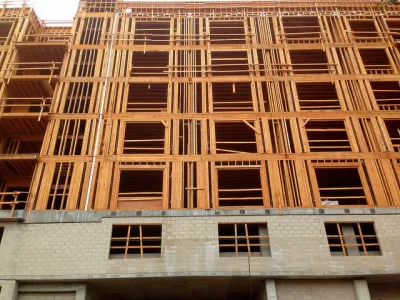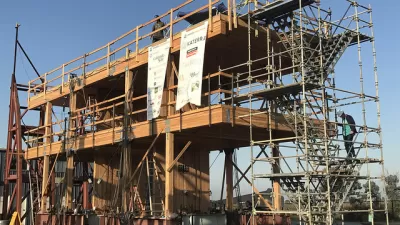A new kind of building will soon rise in the United States: the wooden tower. Extensive testing by the US Department of Agriculture and the timber industry will soon make timber viable for high-rise tower construction.

Although tall wood buildings in countries like Norway and Austria have made headlines around the world, mass timber, as this type of construction is known, has yet to make significant inroads here. Wood dominates low-rise residential construction in the US, but is absent in buildings more than five stories tall.
Many designers, timber industry representatives, and government officials are pushing for that to change. Their motivations vary. Mass timber offers incredible aesthetic benefits and could create new jobs in rural areas. It also holds tremendous potential to mitigate climate change. Carbon-heavy steel and concrete production accounts for almost 5% of the world’s greenhouse gas emissions. Mass timber products require no fossil fuels to produce — trees grow with solar energy alone — and can be replenished through sustainable logging and tree farms. As an added bonus, it can sequester carbon held in trees, preventing it from seeping into the atmosphere when they decay.
In 2014, the United States Department of Agriculture and timber industry partners, enthusiastic about the combination of new jobs and reduced greenhouse gas emissions, launched the U.S. Tall Wood Building Prize Competition. The contest offered $3 million to teams of designers and developers who pledged to build a mass timber tower at least 80 feet high.
FULL STORY: Fire-safety testing paves the way for timber towers

Planetizen Federal Action Tracker
A weekly monitor of how Trump’s orders and actions are impacting planners and planning in America.

San Francisco's School District Spent $105M To Build Affordable Housing for Teachers — And That's Just the Beginning
SFUSD joins a growing list of school districts using their land holdings to address housing affordability challenges faced by their own employees.

The Tiny, Adorable $7,000 Car Turning Japan Onto EVs
The single seat Mibot charges from a regular plug as quickly as an iPad, and is about half the price of an average EV.

Seattle's Plan for Adopting Driverless Cars
Equity, safety, accessibility and affordability are front of mind as the city prepares for robotaxis and other autonomous vehicles.

As Trump Phases Out FEMA, Is It Time to Flee the Floodplains?
With less federal funding available for disaster relief efforts, the need to relocate at-risk communities is more urgent than ever.

With Protected Lanes, 460% More People Commute by Bike
For those needing more ammo, more data proving what we already knew is here.
Urban Design for Planners 1: Software Tools
This six-course series explores essential urban design concepts using open source software and equips planners with the tools they need to participate fully in the urban design process.
Planning for Universal Design
Learn the tools for implementing Universal Design in planning regulations.
Smith Gee Studio
City of Charlotte
City of Camden Redevelopment Agency
City of Astoria
Transportation Research & Education Center (TREC) at Portland State University
US High Speed Rail Association
City of Camden Redevelopment Agency
Municipality of Princeton (NJ)




























